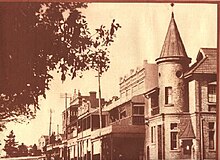|
Kogarah, New South Wales
Kogarah (/kɒɡərə/) is a suburb of Southern Sydney, in the state of New South Wales, Australia. Kogarah is located 14 kilometres (9 miles) south-west of the Sydney central business district and is considered to be the centre of the St George area. LocationKogarah took its name from Kogarah Bay, a small bay on the northern shore of the Georges River. The suburb originally stretched to the bay but has since been divided up to form the separate suburbs of Kogarah Bay and Beverley Park. Kogarah has a mixture of residential, commercial and light industrial areas. It is also known for its large number of schools (including primary school, high school and tertiary education) and health care services (including two hospitals and many medical centres). The NRL side, St George Illawarra Dragons have their Sydney office based at nearby Jubilee Oval, often referred to as Kogarah Oval. Kogarah features all types of residential developments from low density detached houses, to medium density flats and high density high-rise apartments. History Kogarah is derived from an Aboriginal word meaning rushes or place of reeds.[2] It had also been written as 'Coggera', 'Cogerah' and 'Kuggerah' but the current spelling was settled when the railway line came through the area in the 1880s. Early land grants in the area were made to John Townson (1760–1835) who received 910 hectares (2,250 acres) from 1808 to 1810, centred on Hurstville and James Chandler, whose neighbouring estate was centred on Bexley. The district provided fruit, vegetables and oysters for Sydney. In 1869, St Paul's Church of England opened on Rocky Point Road (now Princes Highway). It was built on 0.81 hectares (2 acres) of land given to the church by William Wolfen the Swedish Consul to Sydney, who owned 320 hectares (800 acres) in Kogarah. The suburb grew around the church and the Gardeners Arms Hotel. Kogarah became a municipality in 1885.[3] The former neighbourhood of Moorefield is now part of Kogarah. It was originally a 24-hectare (60-acre) land grant from Governor Lachlan Macquarie in 1812 to Patrick Moore, who built a fine house there. The Moorefield racecourse built by a descendant opened in 1888. Brigadier General John Lamrock CB VD was appointed secretary of the Moorefield Race Club in 1912 and remained in that position until early in 1935.[4] The Moorefield estate was subdivided in the 1950s and the Department of Education purchased 7.7 hectares (19 acres), where it built two high schools and college of further education. Moorefields Girls High School was erected there in 1955 on the former site of Moore's farm.[5] Heritage listingsKogarah has a number of heritage-listed sites, including:
PopulationDemographics
According to the 2021 Australian Bureau of Statistics Census of Population, there were 16,416 people in Kogarah. 36.3% of people were born in Australia. The next most common countries of birth were Nepal 11.3%, China 8.2%, India 6.0%, the Philippines 3.9% and Bangladesh 2.9%. 30.4% of people only spoke English at home. Other languages spoken at home included Nepali 11.6%, Mandarin 7.8%, Cantonese 5.3%, Greek 4.8% and Bengali 3.7%. The most common responses for religious affiliation were No Religion 22.7%, Catholic 17.8%, Hinduism 16.8% and Eastern Orthodox 9.5%.[1] Notable residents
TransportationKogarah railway station is located on the Illawarra line, serving the Sydney suburb of Kogarah. It is served by Sydney Trains T4 line services. Schools and churchesSchools
Churches
References
External linksWikimedia Commons has media related to Kogarah, New South Wales. |
||||||||||||||||||||||||||||||||||||||||||||||||||||||||||||




